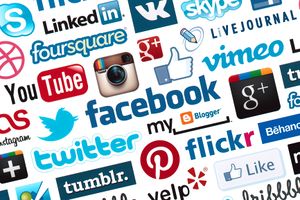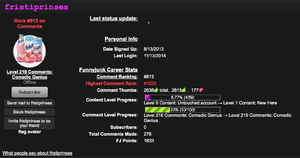Social Media (as Art)
"Social media is the social interaction among people in which they create, share, or exchange information, ideas, and pictures/videos in virtual communities and networks.[1] Composed of multiple, dynamically interacting structures, social media has as a whole evolved into a platform primarily utilized for, but not limited to; self expression, community building, and forming-identities. When these human processes are instantiated freely within the expansiveness of the net, they co-mingle and develop unimpeded within a self-referential system, producing a unique and revealing perspective of the person as a human concept[2], as well, as business concept when one takes into consideration the tremendous capital profit the net has produced. Thus, social media platforms, when filtered through a critical social lens, are in effect compositions of; users expressing themselves, through user-created identities, operating within user-created communities, wholly differentiable mainly by platform structural elements. As such, we are spectators to the digital performance of users creating and operating through their "net" identity; a created cyber version of themselves through which they are able to act, or perform, within the virtual community.[3]
Implications on the Person as a Human Concept
The recursive combination of unhindered expression, net anonymity, and common-interest relationships that social media facilitates and forms is powerful in creating the performance of duality in building human identity. That is, users are given a chance to represent themselves within virtual communities in whatever manner they choose, separate from their identities from the physical social space, in which social norms impose regulations on behaviour. This can range from the simple gesture of the Facebook profile, to MMORPG communities in which users are able to adopt fantasy roles[4], and common-interest virtual communities, such as message boards and forums, where anonymity plays an important role in worry-free expression. It is this social freedom that social media allows in which the dual nature of identity transposes a human performance, one of the gesture of creating and developing artificial persons through which users can live. Thus, found between a persons physical identity and virtual identity, is a unique perspective that exposes the fluidity of human identity, and the gesture people create in navigating through the possibilities of re-creating themselves, or at the very least, re-representing themselves.
Net Identity as Performative
As an art form, net identity is in many ways a performance piece conceptualized within the human trope. If we regard virtual representations of users, their net identities, as functions of self referential human concepts, we transform the user profile, avatar, or persona, into a performance. That is, a performance of the human condition of representation, through the telling middle between the identity created through the relaxed filter of the net, and under rigorous social norms within the physical-space. The decisions that users make in revealing and creating as dialectics through their net identity becomes an art form. This form, as human identity within the online space, is fluid, revealing a multitude of gestures when filtered through the appropriate mechanism for deconstructing it into its pieces, and processing it as a whole. For instance, the decisions users make in what they show and hide in their Facebook profiles, the photos they reveal and delete, all compose a virtual representation, or identity, in which we find the performance of creating oneself.[5] Ergo, the gestures that this performance encapsulates reveal the dichotomy of decision-making and the human-psyche, both fluid functions of online net identity.
Popular Social Media Platforms
- Facebook[6]
- tumblr[7]
- Pinterest[8]
- Youtube[9]
- Twitter[10]
- Instagram[11]
- Flickr[12]
- Funnyjunk[13]
- DeviantArt[14]
- DOTA 2[15]
References
- ↑ http://en.wikipedia.org/wiki/Social_media
- ↑ http://www.looooker.com/wp-content/uploads/2013/12/The-true-self-online.pdf
- ↑ http://www.looooker.com/wp-content/uploads/2013/12/The-true-self-online.pdf
- ↑ http://journal.transformativeworks.org/index.php/twc/article/view/246/230
- ↑ http://www.academia.edu/1878518/Identity_Construction_on_Facebook
- ↑ https://www.facebook.com
- ↑ https://www.tumblr.com
- ↑ https://www.pinterest.com
- ↑ https://www.youtube.com
- ↑ https://www.twitter.com
- ↑ https://www.instagram.com
- ↑ https://www.flickr.com
- ↑ https://www.funnyjunk.com
- ↑ https://www.deviantart.com
- ↑ http://cn.dota2.com


